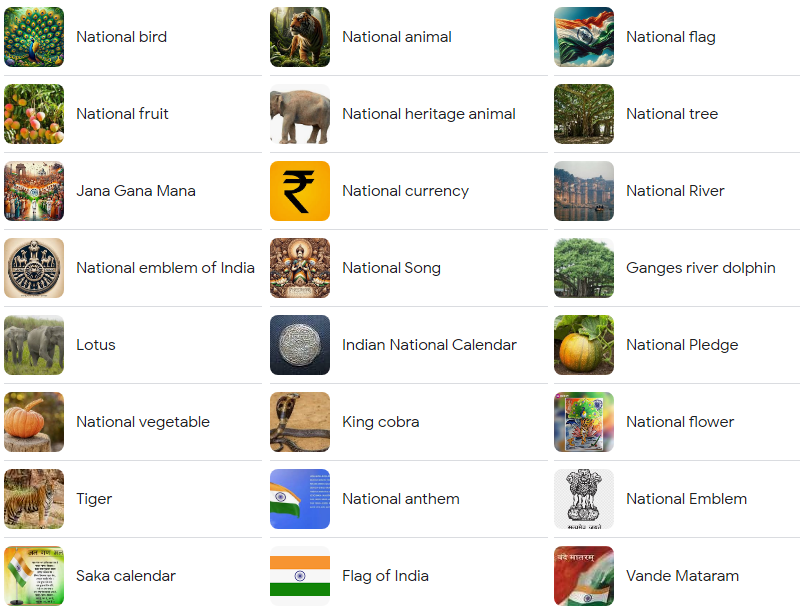Contents
- 1 Explore India’s National Symbols List
- 1.1 The National Flag of India
- 1.2 The National Anthem of India
- 1.3 The National Emblem of India
- 1.4 The National Animal of India
- 1.5 The National Bird of India
- 1.6 The National Flower of India
- 1.7 Conclusion
- 1.8 Explore India’s National Symbols List
- 1.9 FAQ
- 1.9.1 What is the significance of India’s national symbols?
- 1.9.2 What is the national flag of India?
- 1.9.3 What is the national anthem of India?
- 1.9.4 What is the national emblem of India?
- 1.9.5 Which animal is the national animal of India?
- 1.9.6 What is the national bird of India?
- 1.9.7 Which flower is the national flower of India?
Explore India’s National Symbols List
India’s rich cultural heritage is evident through its national symbols. These emblems signify the country’s unity and diversity, representing various aspects of its history, culture, and values. From the national flag to the national animal, these symbols hold immense value and pride for every Indian. In this article, we will delve deep into India’s national symbols list, discussing their significance and relevance in modern times.
Key Takeaways
- India has a diverse range of national symbols that represent its cultural heritage.
- The national flag, national emblem, and national anthem are among the most prominent national symbols of India.
- Each national symbol of India has its unique cultural and historical significance.
- India’s national symbols reflect the ethos of its people and the country’s diverse history and culture.
- These symbols play a crucial role in fostering national unity, pride, and identity.
The National Flag of India
The national flag of India is a tricolor flag with three equal horizontal stripes and a navy blue wheel in the center. The saffron stripe represents courage, sacrifice, and the spirit of renunciation, while the white stripe symbolizes purity, peace, and truth. The green stripe signifies faith, fertility, and chivalry. The wheel at the center is a representation of the Ashoka Chakra, which symbolizes righteousness, progress, and perpetuity.
The design of the national flag was adopted on July 22, 1947, following a rigorous selection process. The flag was first hoisted on August 15, 1947, when India gained independence from British colonial rule. Since then, the national flag has become a symbol of India’s freedom struggle and its rich cultural heritage.
“Our national flag is not just a piece of cloth, but a representation of our rich traditions, values, and history.”
The Indian national flag evokes a sense of pride and patriotism among the citizens of India. It is an important symbol of the country’s independence and national identity. The flag is hoisted on national holidays and special occasions, and it is an honor to hoist and salute the national flag. Hence, it reflects the sentiments and emotions of a nation, and a great deal of respect is attached to it.
The National Anthem of India
The national anthem of India, titled “Jana Gana Mana,” was written by Rabindranath Tagore in 1911. It was officially adopted as India’s national anthem in 1950. The lyrics of the anthem evoke a sense of unity and pride among Indians, celebrating their country’s rich heritage and diversity.
“Jana Gana Mana” is sung at various public events, including sports events, school assemblies, and government functions. The anthem’s melody is set to the raga – ‘Bharati’, making it a truly unique and powerful composition. It has complete 5 paragraphs with 52 seconds of music.
The anthem has been a symbol of national unity, representing the country’s linguistic, religious, and cultural diversity. The Indian Constitution mandates that the national anthem be played or sung on certain occasions, such as the beginning and end of the school day, and before the start of a movie in theaters.
The national anthem plays a crucial role in fostering unity and patriotism among Indians. It evokes emotions of pride, respect, and devotion towards the country’s flag and symbols. Its stirring melody and powerful lyrics have become synonymous with the strength and resilience of the Indian nation.
The National Emblem of India
India’s national emblem is an adaptation of the Lion Capital of Ashoka, an ancient sculpture that was originally situated at Sarnath, a Buddhist sanctuary near Varanasi. The emblem consists of four symbolic components – the Lion Capital, the horse, the bull, and the Dharma Chakra.
The Lion Capital, with its striking figure of four lions standing back to back, represents Ashoka’s commitment to justice, and it has become a symbol of India’s cultural heritage. The horse and the bull, located on either side of the Lion Capital, are the national symbols of perseverance and hard work, respectively. The Dharma Chakra, situated just below the Lion Capital, represents the wheel of life and the teachings of the Buddha.
The national emblem of India is a significant representation of India’s political and cultural values. It is a reflection of India’s rich history and its commitment to justice, perseverance, and the teachings of the Buddha.
The National Animal of India
India’s national animal is the Bengal tiger, scientifically known as Panthera tigris. The tiger is an essential cultural and ecological symbol in India. In Indian culture, the tiger symbolizes power, strength, and grace. Today, there are fewer than 4,000 wild tigers in the world, and India is home to the vast majority of them.
The Bengal tiger’s importance in India’s ecosystem cannot be overstated. As predators, these big cats play a crucial role in keeping the food chain in check. However, jagged forest lines and significant poaching have placed the tiger population in danger. India has implemented various measures to protect the Bengal tiger and ensure its survival, including creating national parks, implementing anti-poaching laws and providing conservation education programs.
The Bengal tiger is the centerpiece of India’s Project Tiger, a national conservation initiative launched in 1973. In addition to protecting the tiger population, Project Tiger has also generated employment opportunities for the local communities residing in the vicinity of tiger reserves.
Hence, the Bengal tiger holds a special place in Indian culture and society, not least because of its importance in preserving the country’s rich ecological heritage.
The National Bird of India
India’s national bird is the peacock, renowned for its resplendent plumage and distinctive dance. This beautiful bird holds a special place in India’s cultural heritage and mythology, having been revered for centuries for its beauty and grace.
The peacock’s intricate and colorful feathers are highly symbolic in Indian culture, representing integrity, royalty, and grace. Its distinctive appearance has also made it a popular motif in Indian art and design.
In Hindu mythology, the peacock is believed to be associated with the god Kartikeya, who was said to ride a peacock into battle. The bird is also associated with Lord Krishna, who is often depicted with a feather in his headband.
| Characteristics | Symbolism |
|---|---|
| The male peacock boasts iridescent blue and green feathers, which it displays in a distinctive fan shape to attract mates. | The peacock’s feathers symbolize beauty, pride, and integrity in Indian culture. |
| The peacock’s dance is an intricate and mesmerizing display, characterized by graceful movements and feather tremors. | The peacock’s dance symbolizes grace, charm, and elegance in Indian culture. |
| The peacock is a social bird, often found in groups known as “musters”. | The peacock’s social behavior represents unity and community in Indian culture. |
The peacock’s status as India’s national bird was declared in 1963, in recognition of its cultural and ecological significance. Today, the peacock is protected under the Wildlife Protection Act of 1972, and efforts are underway to conserve its natural habitat and ensure its survival for future generations to admire and enjoy.
The National Flower of India
India’s national flower is the lotus, a sacred plant in Indian culture, and one of its most beautiful flowers. It is considered a symbol of purity, enlightenment, self-regeneration, and rebirth. The lotus flower is also associated with many Hindu deities, including Vishnu and Lakshmi, and is an essential offering in Hindu worship.
The lotus flower has a unique natural ability to grow and thrive in muddy waters, emerging from the murky depths to blossom as a beautiful flower. This symbolism is used to represent the importance of spiritual and mental purity despite the hardships and impurities of life.
The lotus flower has many uses in Indian culture, from decorative motifs in architecture and textiles to ingredients in traditional medicines and Ayurvedic remedies. The national flower is also a popular subject in Indian art, literature, and music.
The lotus holds a special place in India’s national symbol, appearing in the National Emblem of India, where it is held in a hand of a deity, with an Indian flag in the background. In addition to its significance in cultural and religious contexts, the lotus represents India’s unity in diversity, with its diverse population coming together to form a beautiful nation.
In summary, the lotus, India’s national flower, is a significant symbol of the country’s rich cultural heritage, representing purity, spirituality, and unity in diversity.
Conclusion
In conclusion, India’s national symbols play an essential role in representing the country’s diverse culture and rich heritage. These Indian national items are a source of pride and unity among the people of India and reflect the shared identity of the nation. From the national flag to the national emblem, animal, bird, and flower, each symbol holds significant historical and cultural importance.
The national anthem of India, written by Rabindranath Tagore, is a powerful expression of patriotism and unity. It has the power to evoke strong emotions and instill a sense of pride in every Indian. Similarly, the national emblem of India, with its symbolic elements, represents the country’s cultural and political values.
The national animal, bird, and flower of India have unique cultural and ecological significance. The Bengal tiger, peacock, and lotus flower each hold a special place in Indian mythology and culture, symbolizing bravery, beauty, and purity, respectively.
Overall, these national symbols in India are a testament to India’s diversity, history, and traditions. They serve as a reminder of the country’s rich past and its place in the world today. By upholding and celebrating these symbols, Indians can come together to forge a brighter future for themselves and the world at large.
Explore India’s National Symbols List

- National Bird: Indian Peafowl (Peacock)
- National Animal: Bengal Tiger
- National Flag: Tricolor flag with saffron, white, and green stripes, and a navy blue Ashoka Chakra (wheel) in the center.
- National Fruit: Mango
- National Heritage Animal: Indian Elephant
- National Tree: Banyan
- Jana Gana Mana: National Anthem of India
- National Currency: Indian Rupee (INR)
- National River: Ganges
- National Emblem of India: Lion Capital of Ashoka
- National Song: Vande Mataram
- Ganges River Dolphin: National Aquatic Animal
- Lotus: National Flower
- Indian National Calendar: Saka Calendar
- National Pledge: A pledge of allegiance to the country
- National Vegetable: Pumpkin
- King Cobra: National Reptile
- Tiger: National Animal
- National Anthem: Jana Gana Mana
- National Emblem: Lion Capital of Ashoka
- Saka Calendar: Indian National Calendar
- Flag of India: Tricolor flag with saffron, white, and green stripes, and a navy blue Ashoka Chakra (wheel) in the center.
- Vande Mataram: National Song
FAQ
What is the significance of India’s national symbols?
India’s national symbols hold great cultural and historical significance. They represent the country’s rich heritage and diverse population while fostering a sense of unity and pride among its citizens.
What is the national flag of India?
The national flag of India is a tricolor flag with horizontal stripes of saffron, white, and green. It also features a navy blue Ashoka Chakra in the center. The colors and symbols on the flag hold deep meaning, representing courage, purity, fertility, and growth, respectively.
What is the national anthem of India?
The national anthem of India is called “Jana Gana Mana,” composed by Rabindranath Tagore. It is a patriotic song that celebrates the country’s unity in its diversity and invokes a sense of national pride and loyalty among the people.
What is the national emblem of India?
The national emblem of India is the “Lion Capital of Ashoka,” depicting four lions standing back to back on a circular abacus. It symbolizes power, courage, and righteousness, while the abacus represents culture, law, and order.
Which animal is the national animal of India?
The national animal of India is the Bengal Tiger. It is a majestic creature that represents strength, courage, and beauty. The tiger holds significant ecological importance and plays a vital role in the country’s biodiversity.
What is the national bird of India?
The national bird of India is the Indian Peacock. Known for its vibrant and extravagant plumage, it symbolizes beauty, grace, and pride. The peacock holds a prominent place in Indian mythology and cultural traditions.
Which flower is the national flower of India?
The national flower of India is the Lotus. With its exquisite beauty and cultural significance, the lotus represents purity, spirituality, and rebirth in Indian mythology and is widely used in religious rituals and festivals.




